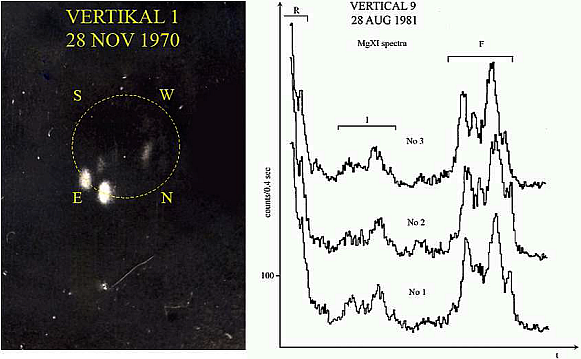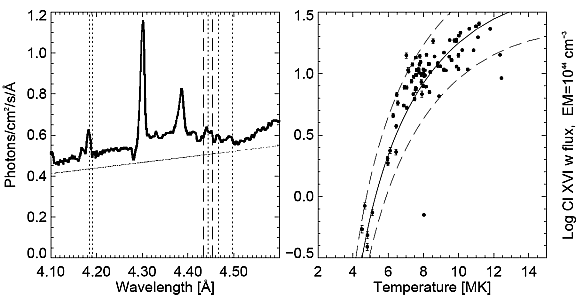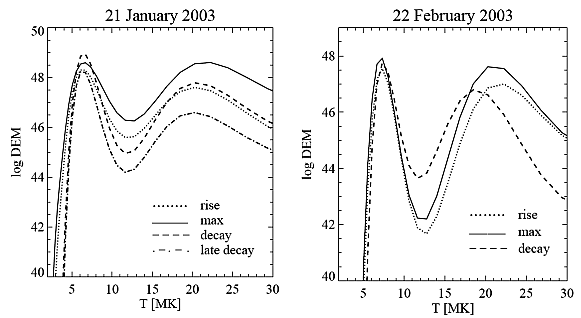AIP Conference Proceedings, vol. 812, pp. 393-396, 2006
Wrocław in Space: X-ray diagnostics of solar corona
Wrocław in Space: X-ray diagnostics of solar corona
M. Siarkowski,
A. Kępa,
B. Sylwester
and
J. Sylwester
Abstract.
X-ray observations of the solar corona have been undertaken in
Solar Physics Division (Space Research Centre of the Polish
Academy of Sciences, Wrocaw) for more than 35 years. Short
history of these observations is presented. We focus mainly on the
results from the latest experiments. These are hard X-ray
photometer onboard the INTERBALL-Tail Probe and two Bragg
crystal spectrometers recording solar X-ray spectra from
CORONAS-F satellite. Such observations provide useful
information on solar coronal plasma heated up to temperatures of
several 106 - 107 K.
Keywords: Solar physics; Solar corona; Solar flares; Solar X-ray
INTRODUCTION
Solar Physics Lab in Wrocaw was stated in 1970 with small
staff of engineers and solar physicists and yet in 1970 first
Polish space experiment took place. It was X-ray spectroheliograph
with pin-hole camera onboard Russian geophysical rocket
Vertical-1. This date also opened international co-operation (at
the beginning mainly with Russian Academy of Sciences) which made
this and next experiments possible. During following 15 years many
rocket experiments were performed. These were mainly photometers,
spectrometer, telescopes and collimators all in the X-ray band. In
Figure 1 the first Polish X-ray image of the Sun (Sylwester, 2001)
together with the first Polish X-ray spectra of the hot solar
corona (Siarkowski and Sylwester, 1985) are presented. In early
90's with technology development a new era of remote satellites
began. Below, we shortly review the results from latest X-ray
satellite experiments. These are X-ray photometer onboard the
INTERBALL-Tail Probe and two Bragg crystal spectrometers
recording solar X-ray spectra from Coronas-F satellite.

FIGURE 1. Left: The first Polish image of the X-ray solar corona obtained
in 1970 using pin-hole camera and Be 50m filter. Dotted circle represents solar
limb and two bright areas show emission from the hot coronal active regions.
Right: The first Polish spectra of the hot X-ray solar corona obtained in
1981. These are three successive spectra around Mg XI He-like ’triplet’ between
9.16 Å and 9.35 Å (R - resonance, I - intercombination, F
- forbidden). Time on the horizontal axis is related to the wavelength by Bragg
equation. The superposition of the line components arising from several active
regions present on the solar disk during measurements is seen.
INTERBALL-TAIL MISSION
RF15-I Soft and Hard X-ray Photometer (Sylwester et al., 2000) was
placed onboard the INTERBALL-Tail satellite lunched on 3
August 1995 and operated continuously up to the middle of October
2000. The photometer was common Polish and Czech Academies of
Scienes project and performed observations of the whole disk solar
X-ray fluxes in the 3-240 keV energy range using two detectors.
The proportional detector nominally measured the soft X-ray solar
fluxes in three energy channels: 2-3 keV, 3-5 keV and 5-8 keV
with the 2 seconds time resolution. The scintillation detector,
NaI(Tl), measured hard X-ray fluxes in five channels:
10-15-30-60-120-240 keV. In the first hard channel (h1:
10-15 keV) the data were collected synchronously with the softer
channels each 2 seconds. In the higher energy channels (h2-h5)
the data were collected every 0.125 s.
Only during the first three years of observations, RF15-I has
registered about 1800 flares (Siarkowski et al., 1999). Using
these data we have identified a class of very soft, low intensity
and long duration flares (Siarkowski et al., 2002a). They have
decay times of the order of hours, low GOES class ( A or
B) and usually no detectable emission above 10 keV. Using soft
X-ray images from YOHKOH satellite we have found, that as
in bigger flares, there is a large diversity in the morphology of
small events.
Because of relative high sensitivity in comparison with other
X-ray photometers RF15-I was especially useful to investigate
small intensity events. This photometer registered many flares
strong in soft X-ray but having not significant emission extending
above 15 or 30 keV and several small soft X-ray intensity events
with noticeable emission above 30 keV (Siarkowski et al., 1999;
Gburek and Siarkowski, 2002).
CORONAS-F
MISSION
The CORONAS-F mission has been launched on July 31, 2001.
Two Polish Bragg spectrometers (constructed in the international
cooperation) have been placed on the satellite platform. The most
interesting results from these spectrometers are presented below.
DIOGENESS
Diogeness was the uncollimated scanning flat crystal spectrometer
(and photometer) observing flare X-ray spectra in four narrow
wavelength bands in the vicinity of Ca XIX, S
XV and Si XIII He-like 'triplets' around 3.18 Å, 5.04 Å and
6.65 Å respectively (Sylwester et al. 2005a). In two spectral
channels, the same emission lines around Ca XIX 3.178 Å
resonance were scanned in opposite directions, which allowed for
Doppler shift measurements. During early phase of the
CORONAS-F mission many big flares have been observed by
Diogeness. In particular, tens of high resolution spectra have
been obtained during initial, maximum and decay phase of
X5.3 flare, on 25 August 2001 (Siarkowski et al. 2002b). An
excellent quality of spectra measured allowed for prompt
identification of a number of spectral features rarely seen before
e.g. spectral features corresponding to transitions in Ar
XVIII  and
Si XIV ions. Analysis of appropriate
line Doppler shifts allowed for line of sight velocities
determination (Płocieniak et al., 2002).
and
Si XIV ions. Analysis of appropriate
line Doppler shifts allowed for line of sight velocities
determination (Płocieniak et al., 2002).
RESIK
RESIK was the bent crystal spectrometer aboard the
CORONAS-F satellite designed to observe solar active region
and flare plasmas spectra (Sylwester et al. 2005a). Silicon and
quartz bent crystals allowed for registration of the spectra in
four wavelength bands from 3.1 Å to 6.1 Å. This spectral
region includes emission lines of Si, S, Cl, Ar, and K from H- and
He-like ions. In third diffraction orders also He-like Fe
(1.85 Å) and Ni (1.55 Å) lines were observed during the most
intense and hot flares. The principal aims of RESIK were the
measurements of relative and absolute element abundances in the
emitting plasma and the temperature distribution of plasma
(DEM-differential emission measure) over the temperature interval
3 MK and 50 MK.
Cl line identification and abundances.
In Figure 2 a part of averaged over 80 time intervals RESIK
spectrum covering the range of expected resonance Cl lines is
shown. Dotted vertical lines indicate for the locations of
theoretical H- and He- like transitions. The vertical dashed lines
bound the region of the Cl resonance line at
 =
4.444 Å taken for the flux determination. The thin line at the
bottom of the spectrum represents the continuum level as
calculated based on the temperature and emission measure estimated
based on the total fluxes measured in channels 1 and 4. Using
these fluxes we have calculated the temperature and emission
measure (in the isothermal approximation) and the Cl resonance
line fluxes for 80 cases. The results are plotted in the right
panel of Figure 2. Theoretical dependencies of Cl line flux on
temperature are presented in the Figure as well. The shapes and
positions of these dashed lines are calculated for assumed unit
emission measure (1044 cm-3) and three different
chlorine abundances: 3.98 10-7, 7.76 10-7 and
1.58 10-6. The middle one fits the observed points the best
and represents the new ACl determination (Sylwester
et al., 2004).
=
4.444 Å taken for the flux determination. The thin line at the
bottom of the spectrum represents the continuum level as
calculated based on the temperature and emission measure estimated
based on the total fluxes measured in channels 1 and 4. Using
these fluxes we have calculated the temperature and emission
measure (in the isothermal approximation) and the Cl resonance
line fluxes for 80 cases. The results are plotted in the right
panel of Figure 2. Theoretical dependencies of Cl line flux on
temperature are presented in the Figure as well. The shapes and
positions of these dashed lines are calculated for assumed unit
emission measure (1044 cm-3) and three different
chlorine abundances: 3.98 10-7, 7.76 10-7 and
1.58 10-6. The middle one fits the observed points the best
and represents the new ACl determination (Sylwester
et al., 2004).

FIGURE 2. Left: The part of RESIK average
spectrum in the vicinity of H- and He- like Cl lines. Right: Chlorine
abundance
determination from Cl resonance
line fluxes (see text for details).
Potassium (K) abundances.
Using RESIK spectra the absolute abundance of potassium has been
determined for the first time from X-ray solar flare line and
continuum spectra (Phillips et al., 2003). Obtained K/H abundance
ratio is (3.7 ±1.0)× 10-7. The absolute and relative
abundances of Ar and S have been also determined. These
measurements confirmed a pattern in which low-FIP elements (as K)
are enriched in the corona by a factor 3 and high-FIP elements
(including S) have equal coronal and photospheric abundances.
A quick-look inspection of RESIK spectra of 1163 events observed
early in 2003 indicates the presence of substantial flare-to-flare
variations in the line-to-continuum ratio of several lines, in
particular He-like potassium (K XVIII) lines (Sylwester et
al., 2005b). The observed variations are larger than expected from
temperature variations. This indicates for the possibility that
there are event-to-event variations in the abundance of potassium.
High n transition lines’ identification.
RESIK observed strong emission lines due to transitions
1s2 -1snp and 1s-np, in
He-like and H-like ions respectively; the n = 2 and 3 lines are
routinely observed for Si, S and Ar ions. For some flares RESIK
has observed enhanced emission in spectral features coinciding
with lines due to transitions for n up to 9 or 10 (Kępa et al.,
2005). Example of identifications of these features, not
previously observed in astrophysical spectra, is presented in
Figure 3 for channels 1 and 2 of RESIK.

FIGURE 3. Average spectra in the
first two RESIK channels with high n transition lines indicated.
DEM.
We have calculated differential emission measure (DEM) based on
Withbroe-Sylwester multiplicative algorithm (Sylwester et al.,
1980; Kępa et al., 2004) and the set of fluxes in several lines
observed by RESIK. In Figure 4 the DEM distributions are presented
for the rise, maximum and decay phase of two solar flares
(Sylwester et al., 2005c). One can notice that the shapes od DEM
represent two component distributions. One component contains the
relatively cold plasma with temperatures between 6 MK and 9 MK and
the other component contains the hotter plasma (T>12 MK). The cold
component is rather stable during the flare evolution while the
hot plasma distributions depend on the flare phase.

FIGURE 4. Time evolution of the DEM
calculated for two solar flares. Left: for 21 January 2003: M1.9, long lasting (240 min in soft
X-ray radiation), limb flare. Right: for 22 February 2003: C5.8, short
lasting (12 min), located at the center of solar disk.
CONCLUSIONS
During 35 years, experimental investigations of X-ray solar
radiation have been undertaken by small group (10 people at
present) working at Solar Physics Division (SPD) within the frame
of Space Research Centre of Polish Academy of Sciences. Several
instruments have been designed at SPD based on new concepts and
launched aboard Russian sounding rockets and satellites. With our
experience in instruments construction, experiment remote control
and data analysis, we hope to continue our work extending
cooperation with other countries and organizations.
REFERENCES
This paper was supported by Polish Ministry of Scientific Research and
Information Technology grant No. 1 P03D 017 29 entitled:
'Investigations of physical conditions and composition of coronal plasma
from X-ray spectra obtained by RESIK, Diogeness and the other instruments'.
- S. Gburek, and M. Siarkowski, 2002, Adv. Space Res.,
30/3, 601-604.
- A. Kępa, J. Sylwester, B. Sylwester, and M. Siarkowski, 2004,
IAU Symposium, No. 223, pp. 461-462.
- A. Kępa, B. Sylwester, J. Sylwester, K.J.H. Phillips, and V.D.
Kuznetsov, 2005, Adv. Space Res., in press.
- S. Płocieniak, J. Sylwester, Z. Kordylewski, and B. Sylwester,
2002, ESA SP Series (SP-506), pp. 963-966.
- K.J.H. Phillips, J. Sylwester, B. Sylwester, and E. Landi, 2003,
Astrophysical Journal, 589, pp. L113-L116.
- M. Siarkowski, J. Sylwester, 1985, Artificial Satellites,
20, pp. 63-75.
- M. Siarkowski, J. Sylwester, S. Gburek, and Z. Kordylewski, 1999,
ESA SP Series (SP-448), pp. 877-882.
- M. Siarkowski, S. Gburek, and P. Rudawy, 2002a, Adv. Space
Res., 30/3, 589-594.
- M. Siarkowski, J. Sylwester, S. Pocieniak, and Z. Kordylewski,
2002b, ESA SP Series (SP-506), pp. 753-756.
- J. Sylwester, J. Schrijver, and R. Mewe, 1980, Solar
Physics, 67, pp. 285-309.
- J. Sylwester, F. Farnik, O. Likin, et al., 2000, Solar
Phys. 197, 337-360.
- J. Sylwester, 2001, ESA SP Series (SP-493), pp. 377-382.
- B. Sylwester, J. Sylwester, M. Siarkowski, K.J.H. Phillips, and
E. Landi, 2004, IAU Symposium, No. 223, pp 671-672.
- J. Sylwester, I. Gaicki, Z. Kordylewski et al., 2005a, Solar
Phys. 226, 45-72.
- J. Sylwester, B. Sylwester, K.J.H. Phillips, J.L. Culhane, C.
Brown, J. Lang, A.I. Stepanov, 2005b, Adv. Space Res.,
in press.
- B. Sylwester, J. Sylwester, A. Kępa, Z. Kordylewski,
K.J.H. Phillips, and V.D. Kuznetsov, 2005c, Astronomichesky
Vestnik, Pleiades Publishing, Inc., to be published.
BACK



